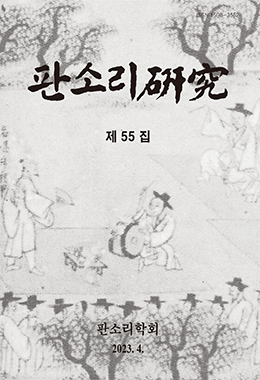이 글에서는 판소리 <춘향가> 중 ‘사랑가’ 대목이 2000년대 이후 한국 대중음악 작품으로 각색된 사례와 그 유형을 살펴보며, 판소리의 대중음악적 각색이 어떤 의미를 지닐 수 있을지를 살펴보았다. ‘사랑가’의 대중음악적 각색은, 원본이 되는 스토리세계에 대해 각색물이 보여주는 반응을 기준으로 세 유형으로 구분할 수 있었다. 먼저 원본을 ‘다시 말하기(retelling)’를 통해 기존의 스토리세계에 종속적인 변화를 도출하는 각색의 유형이 있었고, 두 번째는 원본을 ‘개정(revision)’하면서 기존의 스토리세계를 연장시키고 또 그것을 반성적으로 바라보며 논평하는 유형이 있었다. 마지막으로 세 번째는 원본을 ‘확장(expansion)’하여 기존의 스토리세계에서 벗어난 대안적 서사를 창작한 유형이 있었다.
이 세 유형의 각색 모두 원본에 대한 ‘복제 아닌 반복’이다. 그 속에는 전통적 규범과 문화적 이데올로기와 상징을 보존하고 지켜내려는 지향과, 그것에 문제를 제기하거나 해체해서 새로운 것을 만들어내고자 하는 지향 간의 권력다툼이 존재한다. 이것은 수용자들이 원본과 각색본을 오가거나 비교하면서 작품을 감상하는 동안에도 일어나는 일이다. 원본과 각색본을 동시에 지각해야만 하는 이중적 인식 속에서 판소리의 대중음악적 각색은 재조합된 전통으로서 친숙함 속 기발함을 주고, 현재화된 과거로서 현대사회 대중들의 기대와 요구에 맞는 방식으로 고전을 재해석하게 만들어준다. 또 원본이 되는 판소리에 대해 해박한 지식이 없는 청자들도 음악 속에 활용된 판소리적 요소들을 찾아나가는 과정 그 자체를 통해 상호작용적 유희를 즐기며 즐거움을 얻을 수 있다.
판소리의 대중음악적 각색을 통해 대중들이 간취하게 되는 전통이란 취사선택되며 재조합되고 만들어진 ‘상상의 것’, 다시 말해 현재의 관점에서 재조합된 전통일 수 있다는 점은 한계로 느껴지기도 한다. 하지만 동시에 오늘날의 대중음악 수용자들은 전통 판소리의 내용을 주체적으로 수용하며 자신들의 삶 속으로 끌여들어 재음미하기도 한다는 점에서는 긍정적인 일면을 찾아볼 수 있다. 그런 한편 판소리를 덜 보존하고 있는 각색들이 오히려 판소리에 대한 반응과 궁금증을 이끌어내며 그것을 더 번성하게끔 하는 잠재력을 지녔다는 점 역시 확인할 수가 있었다.
이처럼 판소리의 대중음악적 각색은 이제까지 학계에서 많이 다루어져 온 영상콘텐츠 또는 서사물로의 각색만큼이나 다층적인 지향과 입체성을 보여준다. 대중음악이 현대사회를 살아가는 사람들에게 막강한 영향력을 미치고 있음을 생각해 볼 때, 앞으로도 판소리의 대중음악적 각색에 대해 꾸준히 관심을 갖고 그것을 섬세한 시각으로 분석하는 일이 필요하다.
This study investigated the cases and types of Pansori “Sarang-ga(Love Song)” in Chunhyang-ga adaptation into popular music works since the 2000s, and what adaptation could mean. The adaptation of Pansori “Love Song” can be divided into three types based on the response of the adaptation to the original story world. First, there was a type of adaptation that elicited dependent changes to the existing story world through “retelling.” Second, there was a type that extended the existing story world while “revising” the original and ezamining it reflectively. Lastly, there was a type of creation of an alternative narrative that deviated from the existing story world by “expansion” of the original.
All three types are “repeated and not reproduced” in terms of the original. There is a power struggle between traditional norms, cultural ideologies, and symbols, and the desire to create new things by raising or dismantling problems. This also occurs while the audience appreciates the work while exchanging or comparing the original and the adaptation. In the dual perception of having to perceive the original and the adaptation at the same time, Pansori’s popular music adaptation provieds novelty in familiarity as a recombinant tradition and reinterprets classics in a way that meets the expectations and needs of the modern public as a present-day past. In addition, listeners who do not have extensive knowledge of Pansori can enjoy interactive play and enjoy through the process of finding Pansori elements used in music.
The tradition that the public takes over through the popular musical adaptation of Pansori may be an imaginary element that has been selected and recombined and created, that is, a recombined tradition from the current viewpoint. However, the positive side can be found in that today’s pop music audiences independently accept the contents of traditional Pansori and attract them into their lives and savor them. On the other hand, the adaptations that preserve Pansori have the potential to induce reactions and curiosity about Pansori and make it more prosperous.
As such, the popular music adaptation of Pansori exhibits a multi-layered orientation and three-dimensionality as much as the adaptation of video content or narrative that has been widely dealt with in academia. Considering that popular music has a strong influence on people living in modern society, it is necessary to continue to pay attention to the popular music adaptation of Pansori and analyze it from a delicate perspective.




